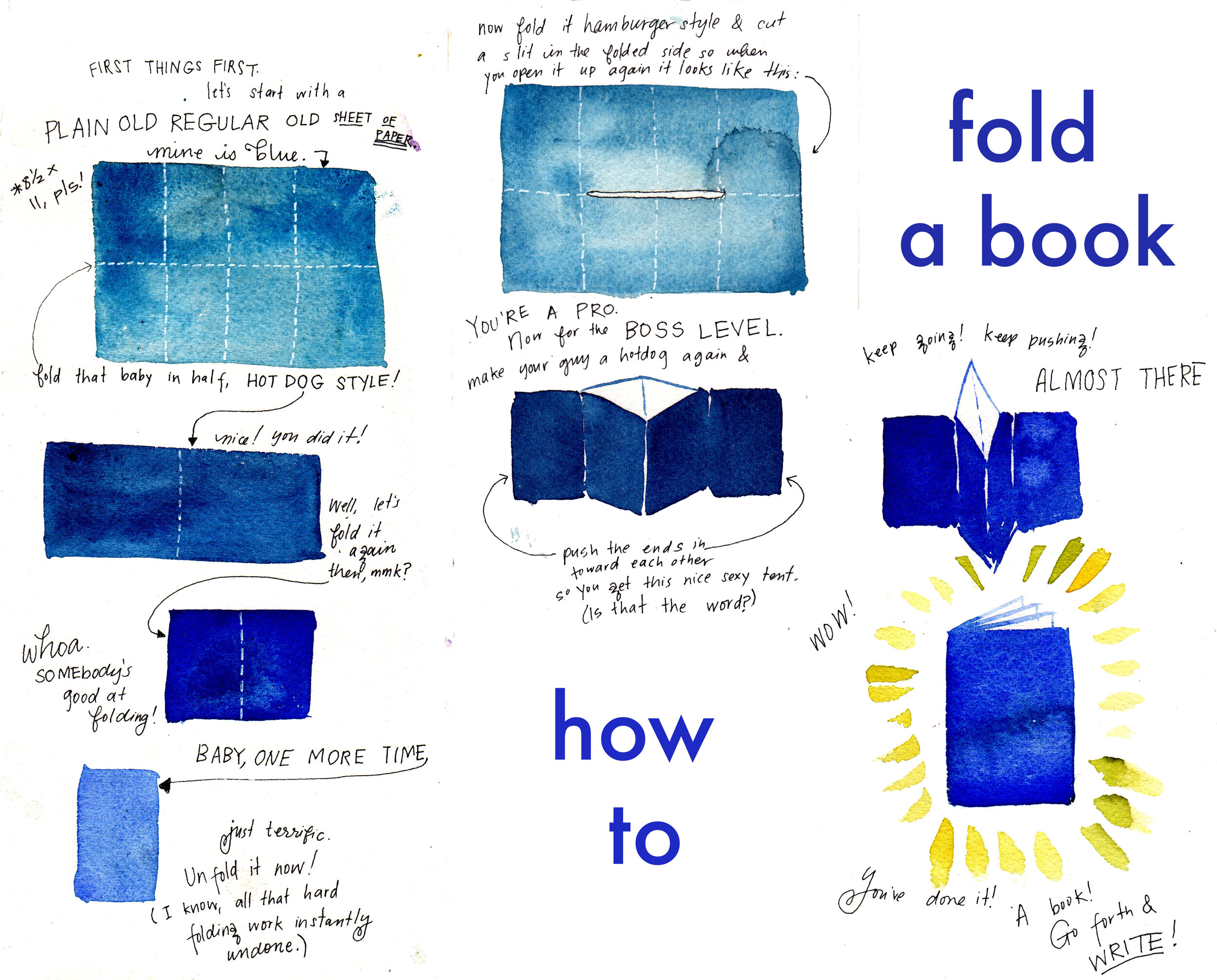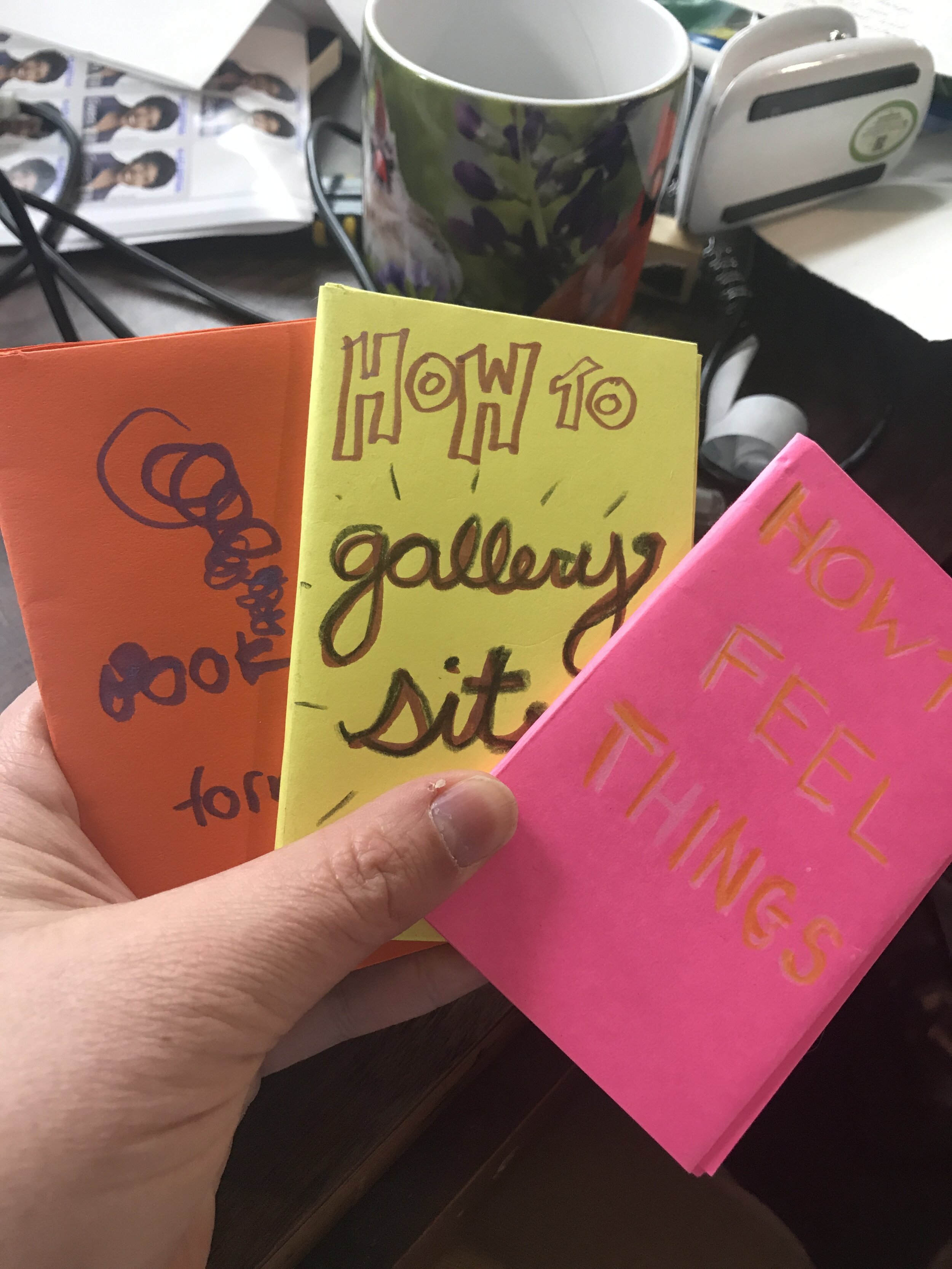I am writing 100 How-To essays. It is a big project. Here is why I am doing it. This is essay 47 of 100.
Although I understand that I am about to commit a great transgression of cliche, I’d like to begin with a pair of definitions. What is a book? And what makes something little?
I don’t have a dictionary handy (or the internet, which I’m sure you’ll find hard to believe, but I’m writing on a treadmill), so these definitions are drawing only upon my 34 years of experience and nothing more.
A book is a collection of pages that have been bound. I am going to lean into this simple definition because it allows for a book to take on so many forms, as it should. A book says, “One page is not enough pages. We need more than one.” It also says, “I want you to have the convenience of being able to throw these pages all over the place without needing to reorganize them. And therefore I, the book, am an object that implies care.” You may be wondering about ebooks, since they are not, technically speaking, bound. Ebooks have their own word because they are their own thing, and for our purposes, a book is something you can hold. If holding something doesn’t seem immediately important to you, please stop reading this essay, take off your shoes, and put your toes in some grass. It’s probably been too long since you’ve done that.
So, then, is a term paper that’s stapled at the corner a book? Sure. I’m going to say that that is a book. I think calling it a book will encourage my students (and all students, let’s hope) to staple their term papers. A stapled paper is weirdly uncommon in 2020. I guess staplers are fewer and farther between than they once were. I carry one in my backpack, and when it’s not a global pandemic I replace the staple cartridge roughly one time per week, all because of unstapled term papers. (I’m calling them term papers, but that’s kind of not true. I’m talking here about all papers that are more than one page long, which is most of them. And maybe you’re thinking that kids don’t staple their papers because they know they can come to class and I’ll have a stapler in my backpack, and so I’m really just enabling their bad non-stapling habits, and I’ll probably be a terrible mom if I ever become a mom. Sure. You may be right.)
But a stapled term paper isn’t a whole lot of fun, whether or not you regard it as a book. And for this reason, I am going to define the word “little” as being smaller than a term paper.
My first little books were made for my sister when we lived in Washington, DC. I was in first grade, and because a bully stole my sweater in the first week or so of school, my mom let me stay home a lot. With all this stay-home time, we went to libraries and playgrounds, which probably made me fall in love with libraries and playgrounds — and I am still in love with them to this day. The library was especially unfathomable, filled with books as it was, and the books all being free to borrow as they were. But I was greedy and this wasn’t enough, and I wanted to not only have my own library in my house, I wanted the library to be filled with books that I had written myself about only topics that interested me. Which included and were limited to horses, princesses, princess horses, and cake.
So I started to steal whole reams of printer paper, squirreling them away under the glass coffee table in the living room, where I also kept the other mainstays of my printing studios: a gray Swingline, a pencil with an eraser, and 24 crayons.
If I was the kind of child I wish I had been — careful, quiet, still, daydreamy — I would now describe to you how I spent hours creating my little books, and how meticulously and charmingly badly I colored in every horse and princess on every page. But this was not at all the child I was. I exemplified (and I think I still do; take this 100 how-to essays project as proof) quantity over quality. The books were made hastily, and I never used the crayons, and after a while I stopped using the pencil with the eraser too, opting for my dad’s ballpoint pen that had fallen out of his pocket once and become my definitive property.
Here is how I made a little book: I took two pieces of printer paper (because my writerly attention span could not breach a 4 page max) and folded them in half. I stapled parallel to the crease, which often made the pages inside the book very small, because I would overshoot how far from the crease to put my staples.
The books were ostensibly made for my sister Alexis, who didn’t want them or need them, as we had plenty of real children’s books made by actual writers and illustrators that were 32 epics pages long each. Her disinterest in the library I created for her forced me to add the non-Sophie-created books to the catalogue — which she was only allowed to “check out” if she also took a Sophie book. When she checked out a book at the library I used a crayon to make a checkmark in the front of each book, indicating that the had borrowed this book and would need to return it to the library, which was caddy-corner to the printing press under the coffee table. And that’s the story of how I destroyed all of the beautiful hardbound books my family owned with crayons.
In college, however, I decided to minor in book arts. I told a lot of people I accomplished this goal, when in fact I didn’t technically earn the minor because you needed to take a ceramics or sculpture class to qualify, and clay literally turns to dust when in touches my hands, so I had to drop that class lest I destroy a potting wheel, which felt probable.
I did take all the book arts classes, though, and loved them so much that I briefly dabbled with the idea of going to grad school to pursue bookmaking. Even in the intro class it was obvious that the book was the Trojan horse of all the art forms. You can do anything in a book. You can paint in a book, or do letterpress, or write poems, or make dried flower collages, or even do stupid (non-clay based, granted) sculptures alá pop-up books. Books had it all.
But the truth is that Ms. Quantity-Over-Quality here wasn’t all that good at book arts. To be really good at it, you have to be a perfectionist. What I had was passion and the ability to prattle on in enormous loving platitudes to my book arts teacher about how much I loved book arts. That is how I achieved my glory in book arts; not because I was any good at it.
By now I hope I have convinced you that I am qualified to explain to you how to make a little book.
I am going to teach you how to make FOUR TYPES of little books, not by using my actual knowledge or skill, but by describing each book type, and then linking a YouTube video made by a person who is likely a perfectionist and much more capable of explaining bookmaking to you.
Single-sheet mini zine
This is a six-page book that requires zero supplies except for a single sheet of paper. (This is the book in the illustration I’ve provided at the top.) The hardest part is the folding, but persevere! After you get it one time, you will never feel frustrated with it again. This is a terrific format to create top 6 lists! It is also a great and whimsical skeleton of a letter to send to a friend.
Last year I had my first (and probably only) gallery show in New Orleans. I have not written about this at all because a sad thing happened at the end of the visit (I flew out to install it, and for the opening), and it ultimately was one of the worst weeks of my life, but not because of the show. However, I associate the sad thing WITH the show, which is really not fair to the show, but such are the casualties of grief. At this show, my friend Ari and I made blank books of this model so that visitors could make into their own art projects to leave or take. What ended up happening was that I made three, Ari made one, my partner Bob made one, and then pretty much no one else made one, because this is an ART GALLERY, Sophie, and not a MONTESSORI SCHOOL. But anyway, here are some of the ones I still have:
Stapled zine
These are a step up from the “books” I made for my “library.” It is most fun to employ a long-armed stapler here, but there are workarounds, and who doesn’t love a good zine?
The saddle stitch
When I am trying to fall asleep at night, I play a loop of someone doing this basic “signature” binding in my mind because I can think of nothing more peaceful. (A “signature” in a book is one section of collected pages that have been attached to OTHER signatures to make the whole entire book. I didn’t say I didn’t pay ATTENTION in book arts class.)
Japanese side-stitch, or punch stitch
The prettiest book binding, but also the most difficult to get right. Someone gave me the most beautiful book about how to make these, and it has intimidated me for six years while also making me feel special and cool because there was one human one time who believed that I was ready for a craft book like that.
Basic case binding
It’s quarantine! Do you want to make a hard bound book? All you need is fabric, glue, and cardboard! It won’t be the prettiest book with those cheap plebeian supplies, but it will be A REAL HARD BOUND BOOK.
A little book makes a wonderful gift, but it’s also tremendously liberating to decide that you are going to make a little book just for you, just because it is fun, just to mark this moment in time with the Trojan horse of art forms.


